Interactive Impacts of Temperature and Elevated CO2 on Basil (Ocimum basilicum L.) Root and Shoot Morphology and Growth
Abstract
1. Introduction
2. Materials and Methods
2.1. Temperature and CO2 Treatments
2.2. Morphophysiological Measurements
2.3. Root Image Acquisition and Analysis
2.4. Physiological Measurements
2.5. Epicuticular Wax Content Determination
2.6. Data Analysis
3. Results
3.1. Shoot Growth and Morphology
3.2. Root Development Parameters
3.3. Physiological Parameters
4. Discussion
5. Conclusions
Author Contributions
Funding
Institutional Review Board Statement
Informed Consent Statement
Data Availability Statement
Acknowledgments
Conflicts of Interest
Abbreviations
References
- USGCRP. Impacts, Risks, and Adaptation in the United States: Fourth National Climate Assessment, Volume II; Reidmiller, D.R., Avery, C.W., Easterling, D.R., Kunkel, K.E., Lewis, K.L.M., Maycock, T.L., Stewart, B.C., Eds.; US Global Change Research Program: Washington, DC, USA, 2018; p. 1515.
- Baker, H. Atmospheric CO2 Will Pass an Alarming Milestone in 2021. Available online: https://www.livescience.com/co2-concentration-rising-past-alarming-threshold.html (accessed on 8 February 2021).
- IPCC. Climate Change 2014: Impacts, Adaptation, and Vulnerability. Part A: Global and Sectoral Aspects. Contribution of Working Group II to the Fifth Assessment Report of the Intergovernmental Panel on Climate Change; Field, C.B., Barros, V.R., Dokken, D.J., Mach, K.J., Mastrandrea, M.D., Bilir, T.E., Chatterjee, M., Ebi, K.L., Estrada, Y.O., Genova, R.C., et al., Eds.; Cambridge University Press: Cambridge, UK; New York, NY, USA, 2014; p. 1132. [Google Scholar]
- Stocker, T.F.; Qin, D.; Plattner, G.-K.; Tignor, M.; Allen, S.K.; Boschung, J.; Nauels, A.; Xia, Y.; Bex, V.; Midgley, P.M. Climate Change 2013: The Physical Science Basis. Intergovernmental Panel on Climate Change, Working Group I Contribution to the IPCC Fifth Assessment Report (AR5); Cambridge University Press: New York, NY, USA, 2013; p. 25. [Google Scholar]
- Reddy, A.R.; Reddy, K.R.; Hodges, H.F. Interactive effects of elevated carbon dioxide and growth temperature on photosynthesis in cotton leaves. Plant Growth Regul. 1998, 26, 33–40. [Google Scholar] [CrossRef]
- Dong, J.; Gruda, N.; Li, X.; Tang, Y.; Zhang, P.; Duan, Z. Sustainable vegetable production under changing climate: The impact of elevated CO2 on yield of vegetables and the interactions with environments-A review. J. Clean. Prod. 2020, 253, 119920. [Google Scholar] [CrossRef]
- Simon, J.E.; Quinn, J.; Murray, R.G. Basil: A Source of Essential Oils. In Adv. New Crops; Janick, J., Simon, J.E., Eds.; Timber Press: Portland, OR, USA, 1990; pp. 484–489. [Google Scholar]
- Kopsell, D.A.; Kopsell, D.E.; Curran-Celentano, J. Carotenoid and chlorophyll pigments in sweet basil grown in the field and greenhouse. Hort. Sci. 2005, 40, 1230–1233. [Google Scholar] [CrossRef]
- Chang, X.; Alderson, P.; Wright, C. Effect of temperature integration on the growth and volatile oil content of basil (Ocimum Basilicum L.). J. Hortic. Sci. Biotechnol. 2005, 80, 593–598. [Google Scholar] [CrossRef]
- Ribeiro, P.; Simon, J.E. Breeding sweet basil for chilling tolerance. In Issues in New Crops and New Uses; Janick, J., Whipkey, A., Eds.; ASHS Press: Alexandria, VA, USA, 2007; pp. 302–305. [Google Scholar]
- Mortensen, L.M. The effect of air temperature on growth of eight herb species. Amer. J. Plant Sci. 2014, 5, 1542–1546. [Google Scholar] [CrossRef][Green Version]
- Hiltunen, R.; Holm, Y. Essential of oil of Ocimum. In Basil: The Genus Ocimum; Hiltunen, R., Holm, Y., Eds.; Harwood academic publishers: Amsterdam, The Netherlands, 1999; pp. 113–135. [Google Scholar]
- Walters, K.J.; Currey, C.J. Growth and development of basil species in response to temperature. Hort. Sci. 2019, 54, 1915–1920. [Google Scholar] [CrossRef]
- Watanabe, C.K.; Sato, S.; Yanagisawa, S.; Uesono, Y.; Terashima, I.; Noguchi, K. Effects of elevated CO2 on levels of primary metabolites and transcripts of genes encoding respiratory enzymes and their diurnal patterns in Arabidopsis thaliana: Possible relationships with respiratory rates. Plant Cell Physiol. 2014, 55, 341–357. [Google Scholar] [CrossRef] [PubMed]
- Jaouni, S.A.; Saleh, A.M.; Wadaan, M.A.M.; Hozzein, W.N.; Selim, S.; AbdElgawad, H. Elevated CO2 induces a global metabolic change in basil (Ocimum Basilicum L.) and peppermint (Mentha Piperita L.) and improves their biological activity. J. Plant Physiol. 2018, 224–225, 121–131. [Google Scholar] [CrossRef]
- de Dorlodot, S.; Forster, B.; Pagès, L.; Price, A.; Tuberosa, R.; Draye, X. Root system architecture: Opportunities and constraints for genetic improvement of crops. Trends Plant Sci. 2007, 12, 474–481. [Google Scholar] [CrossRef] [PubMed]
- Luo, H.; Xu, H.; Chu, C.; He, F.; Fang, S. High temperature can change root system architecture and intensify root interactions of plant seedlings. Front. Plant Sci. 2020, 11, 160. [Google Scholar] [CrossRef] [PubMed]
- Bardgett, R.D.; Mommer, L.; De Vries, F.T. Going underground: Root traits as drivers of ecosystem processes. Trends Ecol. Evol. 2014, 29, 692–699. [Google Scholar] [CrossRef] [PubMed]
- Fitter, A.H.; Caldwell, M.M.; Pearcy, R.W. Architecture and biomass allocation as components of the plastic response of root systems to soil heterogeneity. In Exploitation of Environmental Heterogeneity by Plants: Ecophysiological Processes Above-And Belowground; Academic Press: Cambridge, MA, USA, 1994; pp. 305–323. [Google Scholar]
- Brand, D.; Wijewardana, C.; Gao, W.; Reddy, K.R. Interactive effects of carbon dioxide, low temperature, and ultraviolet-b radiation on cotton seedling root and shoot morphology and growth. Front. Earth Sci. 2016, 10, 607–620. [Google Scholar] [CrossRef]
- Wijewardana, C.; Henry, W.B.; Gao, W.; Reddy, K.R. Interactive effects on CO2, drought, and ultraviolet-b radiation on maize growth and development. J. Photochem. Photobiol. B. 2016, 160, 198–209. [Google Scholar] [CrossRef] [PubMed]
- Lahti, M.; Aphalo, P.J.; Finér, L.; Ryyppö, A.; Lehto, T.; Mannerkoski, H. Effects of soil temperature on shoot and root growth and nutrient uptake of 5-year-old norway spruce seedlings. Tree Physiol. 2005, 25, 115–122. [Google Scholar] [CrossRef]
- Balliu, A.; Sallaku, G. The environment temperature affects post-germination growth and root system architecture of pea (Pisum Sativum L) plants. Sci. Hortic. 2021, 278, 109858. [Google Scholar] [CrossRef]
- Reddy, K.; Read, J.J.; McKinion, J.M. Soil-Plant-Atmosphere-Research (SPAR) facility: A Tool for plant research and modeling. Biotronics 2001, 30, 27–50. [Google Scholar]
- Wijewardana, C.; Hock, M.; Henry, B.; Reddy, K.R. Screening corn hybrids for cold tolerance using morphological traits for early-season seeding. Crop Sci. 2015, 55, 851–867. [Google Scholar] [CrossRef]
- Hoagland, D.R.; Arnon, D.I. The Water-Culture Method for Growing Plants without Soil, 2nd ed.; Circular 347; California Agricultural Experiment Station: Berkeley, CA, USA, 1950; p. 347. [Google Scholar]
- Bannayan, M.; Tojo Soler, C.M.; Garcia y. Garcia, A.; Guerra, L.C.; Hoogenboom, G. Interactive effects of elevated [CO2] and temperature on growth and development of a short- and long-season peanut cultivar. Clim. Chang. 2009, 93, 389–406. [Google Scholar] [CrossRef]
- Ebercon, A.; Blum, A.; Jordan, W.R. A rapid colorimetric method for epicuticular wax contest of sorghum leaves. Crop Sci. 1977, 17, 179–180. [Google Scholar] [CrossRef]
- Singh, S.K.; Reddy, K.R. Regulation of photosynthesis, fluorescence, stomatal conductance and water-use efficiency of cowpea (Vigna Unguiculata [L.] Walp.) under drought. J. Photochem. Photobiol. B Biol. 2011, 105, 40–50. [Google Scholar] [CrossRef]
- Yuan, L.; Yuan, Y.; Liu, S.; Wang, J.; Zhu, S.; Chen, G.; Hou, J.; Wang, C. Influence of high temperature on photosynthesis, antioxidative capacity of chloroplast, and carbon assimilation among heat-tolerant and heat-susceptible genotypes of nonheading chinese cabbage. HortScience 2017, 52, 1464–1470. [Google Scholar] [CrossRef]
- Al-Huqail, A.; El-Dakak, R.M.; Sanad, M.N.; Badr, R.H.; Ibrahim, M.M.; Soliman, D.; Khan, F. Effects of climate temperature and water stress on plant growth and accumulation of antioxidant compounds in sweet basil (Ocimum basilicum L.) leafy vegetable. Scientifica 2020, 3808909. [Google Scholar] [CrossRef] [PubMed]
- Caliskan, O.; Odabas, M.S.; Cirak, C. The modeling of the relation among the temperature and light intensity of growth in Ocimum basilicum L. J. Med. Plants Res 2009, 3, 965–977. [Google Scholar] [CrossRef]
- Yamauchi, A.; Pardales, J.R., Jr.; Kono, Y. Root system structure and its relation to stress tolerance. In Dyanamics of Roots and Nitrogen in Cropping Systems of the Semi-Arid Tropics; Ito, O., Johansen, C., Adu-Gyamfi, J.J., Katayama, K., Kumar, J.V.D.K., Rego, T.J., Eds.; Japan International Research Center for Ag Sciences: Tsukuba, Japan, 1996; pp. 211–233. [Google Scholar]
- Aidoo, M.K.; Bdolach, E.; Fait, A.; Lazarovitch, N.; Rachmilevitch, S. Tolerance to high soil temperature in foxtail millet (Setaria Italica L.) Is related to shoot and root growth and metabolism. Plant Physiol. and Biochem. 2016, 106, 73–81. [Google Scholar] [CrossRef] [PubMed]
- Nagel, K.A.; Kastenholz, B.; Jahnke, S.; van Dusschoten, D.; Aach, T.; Mühlich, M.; Truhn, D.; Scharr, H.; Terjung, S.; Walter, A.; et al. Temperature responses of roots: Impact on growth, root system architecture and implications for phenotyping. Funct. Plant Biol. 2009, 36, 947–959. [Google Scholar] [CrossRef] [PubMed]
- Kaspar, T.C.; Bland, W.L. Soil temperature and root growth. Soil Sci. 1992, 154, 290–299. [Google Scholar] [CrossRef]
- De Kroon, H.; Mommer, L.; Nishiwaki, A. Root competition: Towards a mechanistic understanding. In Root Ecology; de Kroon, H., Visser, E.J.W., Eds.; Ecological Studies (Analysis and Synthesis); Springer: Berlin/Heidelberg, Germany, 2003; Volume 168, pp. 215–234. ISBN 978-3-662-09784-7. [Google Scholar]
- Shamloo, M.; Babawale, E.A.; Furtado, A.; Henry, R.J.; Eck, P.K.; Jones, P.J.H. Effects of genotype and temperature on accumulation of plant secondary metabolites in canadian and australian wheat grown under controlled environments. Sci. Rep. 2017, 7, 9133. [Google Scholar] [CrossRef] [PubMed]
- Sublett, W.L.; Barickman, T.C.; Sams, C.E. Effects of elevated temperature and potassium on biomass and quality of dark red ‘lollo rosso’ lettuce. Horticulturae 2018, 4, 11. [Google Scholar] [CrossRef]
- Jumrani, K.; Bhatia, V.S. Interactive effect of temperature and water stress on physiological and biochemical processes in soybean. Physiol. Mol. Biol. Plant. 2019, 25, 667–681. [Google Scholar] [CrossRef] [PubMed]
- Reddy, K.R.; Seghal, A.; Jumaa, S.; Bheemanahalli, R.; Kakar, N.; Redoña, E.D.; Wijewardana, C.; Alsajri, F.A.; Chastain, D.; Gao, W.; et al. Morpho-Physiological characterization of diverse rice genotypes for seedling stage high- and low-temperature tolerance. Agronomy 2021, 11, 112. [Google Scholar] [CrossRef]
- Ronga, D.; Rizza, F.; Badeck, F.-W.; Milc, J.; Laviano, L.; Montevecchi, G.; Pecchioni, N.; Francia, E. Physiological responses to chilling in cultivars of processing tomato released and cultivated over the past decades in southern europe. Sci. Hortic. 2018, 231, 118–125. [Google Scholar] [CrossRef]
- Agati, G.; Tuccio, L.; Kusznierewicz, B.; Chmiel, T.; Bartoszek, A.; Kowalski, A.; Grzegorzewska, M.; Kosson, R.; Kaniszewski, S. Nondestructive optical sensing of flavonols and chlorophyll in white head cabbage (Brassica Oleracea L. Var. Capitata Subvar. Alba) grown under different nitrogen regimens. J. Agric. Food Chem. 2016, 64, 85–94. [Google Scholar] [CrossRef] [PubMed]
- de Freitas, G.M.; Thomas, J.; Liyanage, R.; Lay, J.O.; Basu, S.; Ramegowda, V.; do Amaral, M.N.; Benitez, L.C.; Bolacel Braga, E.J.; Pereira, A. Cold Tolerance response mechanisms revealed through comparative analysis of gene and protein expression in multiple rice genotypes. PLoS ONE 2019, 14, e0218019. [Google Scholar] [CrossRef] [PubMed]
- Cerovic, Z.G.; Masdoumier, G.; Ghozlen, N.B.; Latouche, G. A New optical leaf-clip meter for simultaneous non-destructive assessment of leaf chlorophyll and epidermal flavonoids. Physiol. Plant. 2012, 146, 251–260. [Google Scholar] [CrossRef] [PubMed]
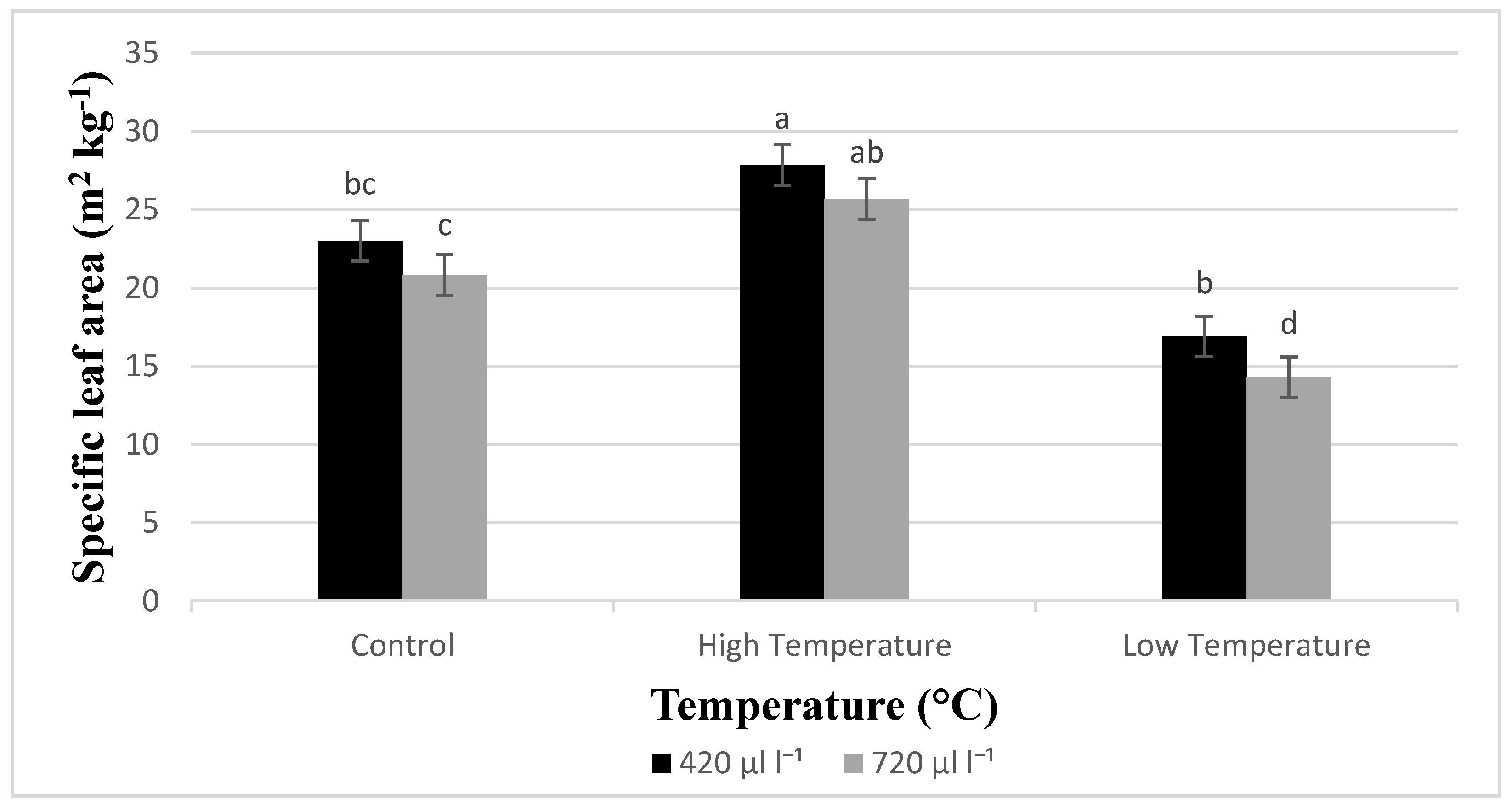
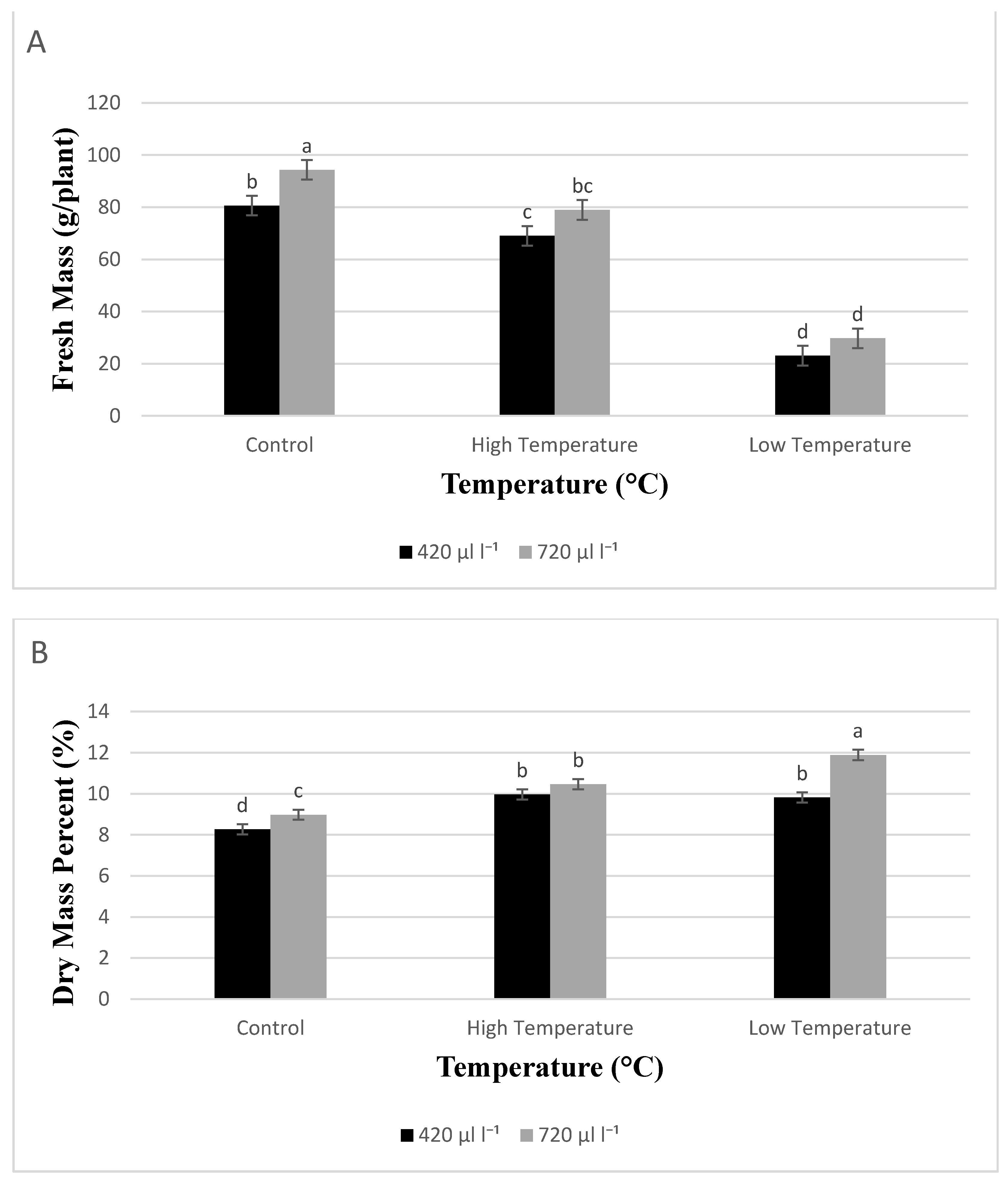
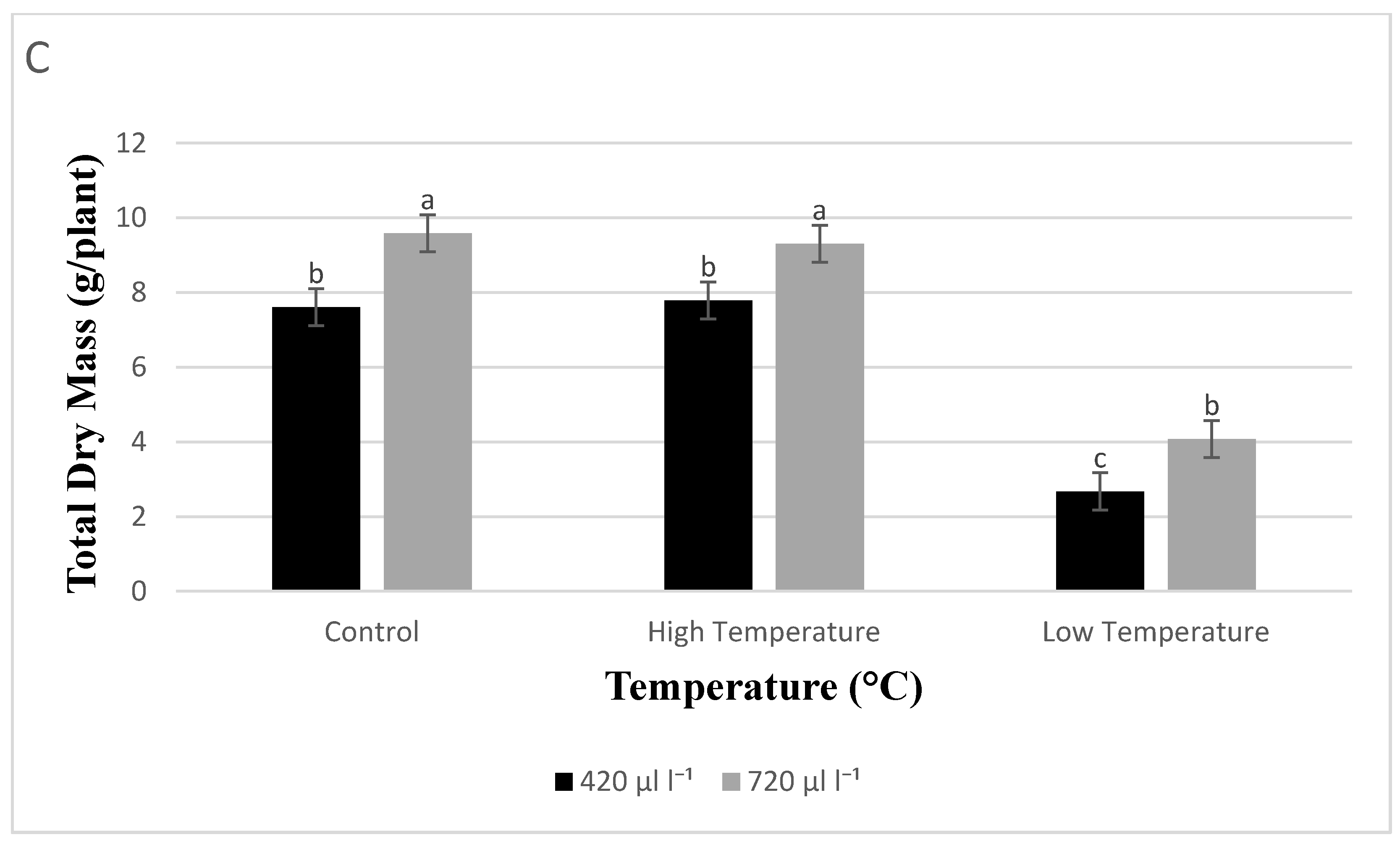

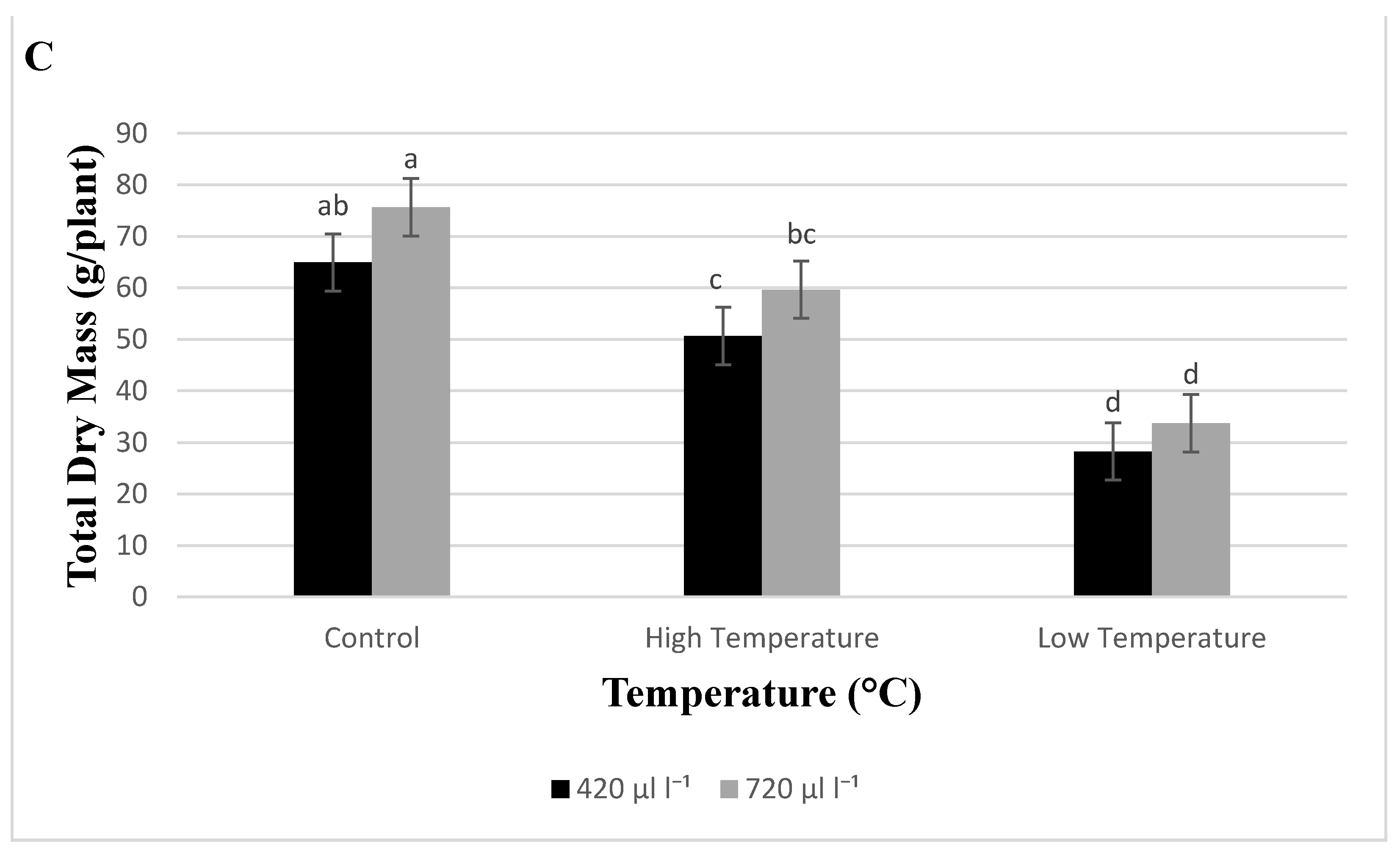
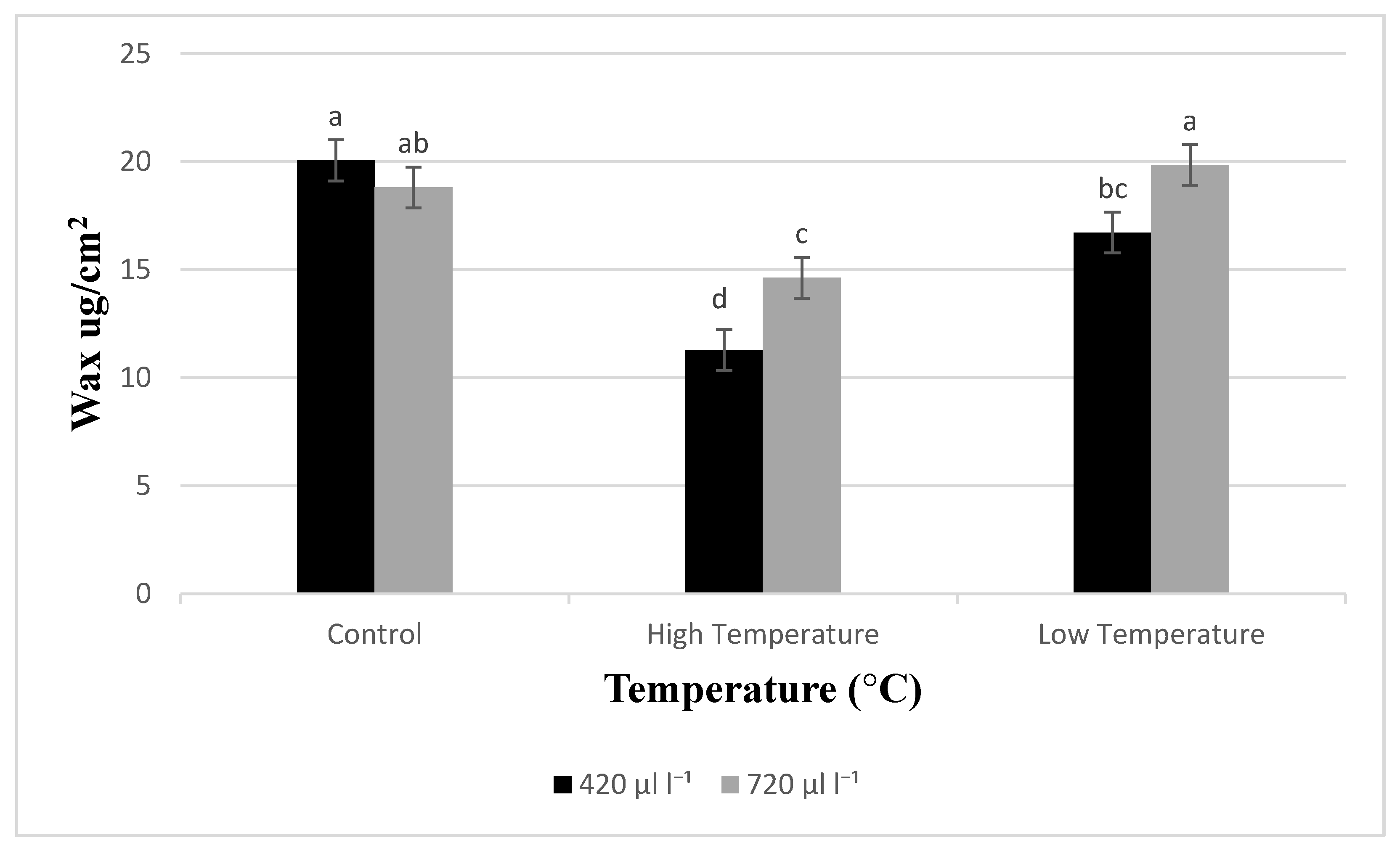
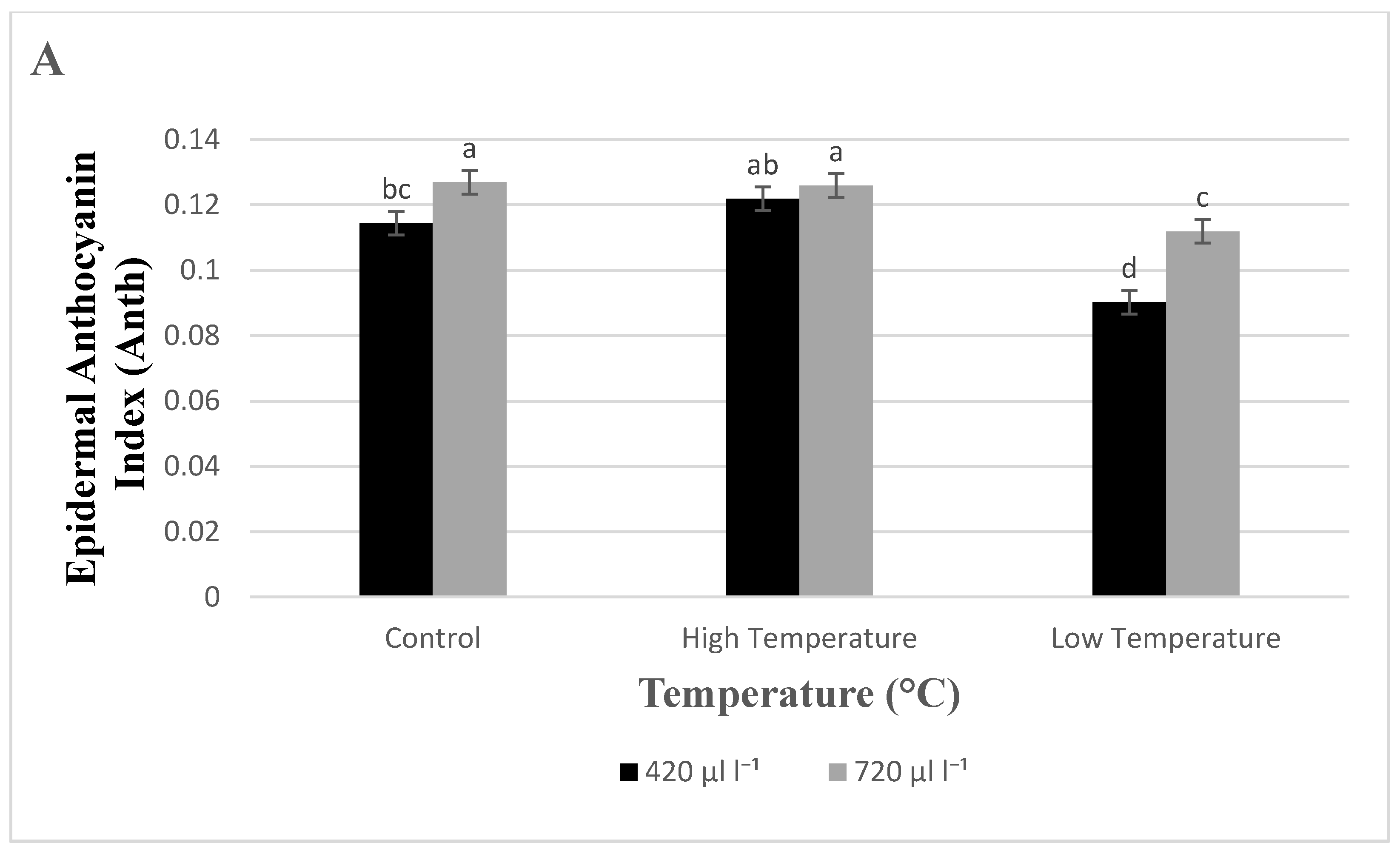
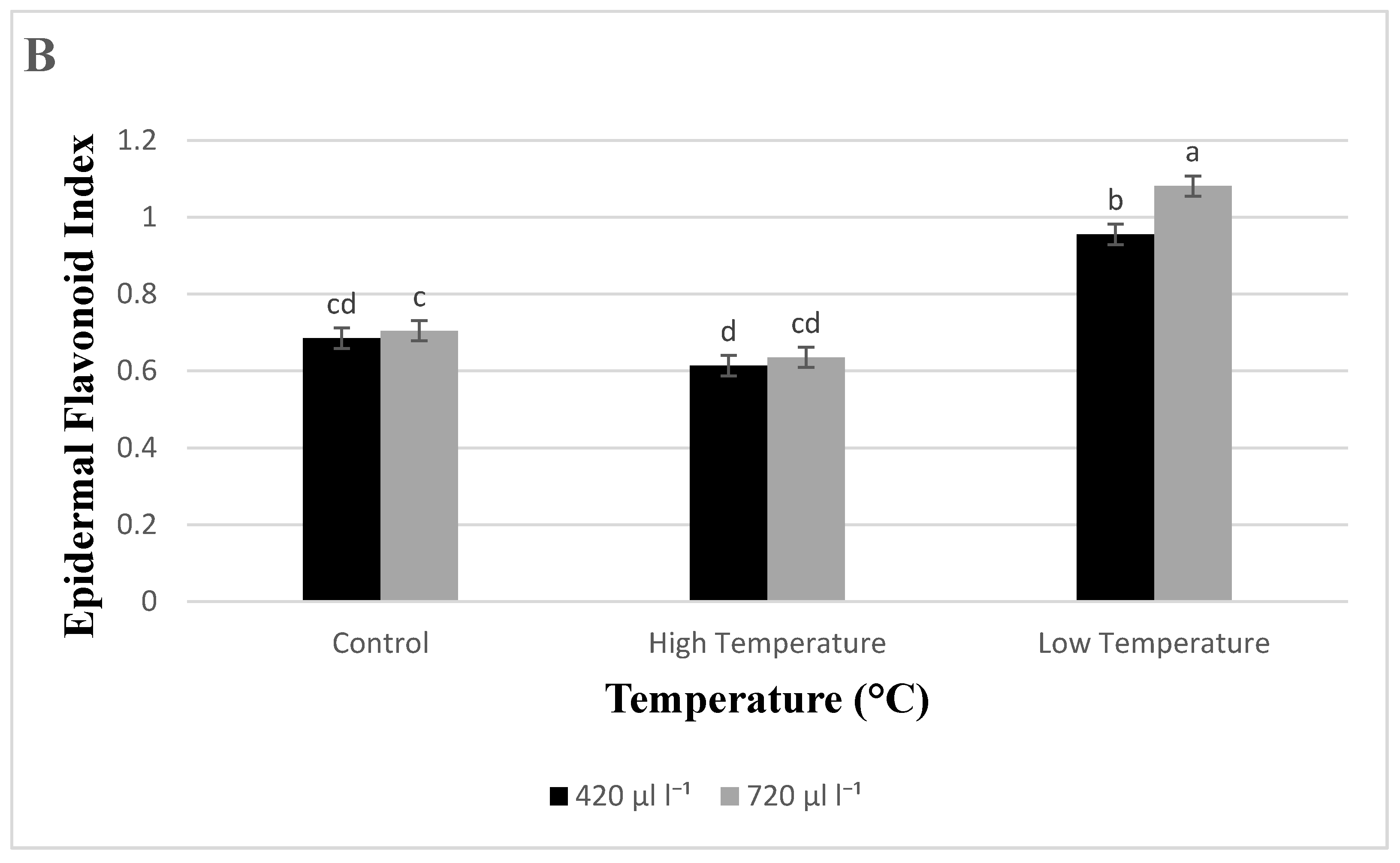
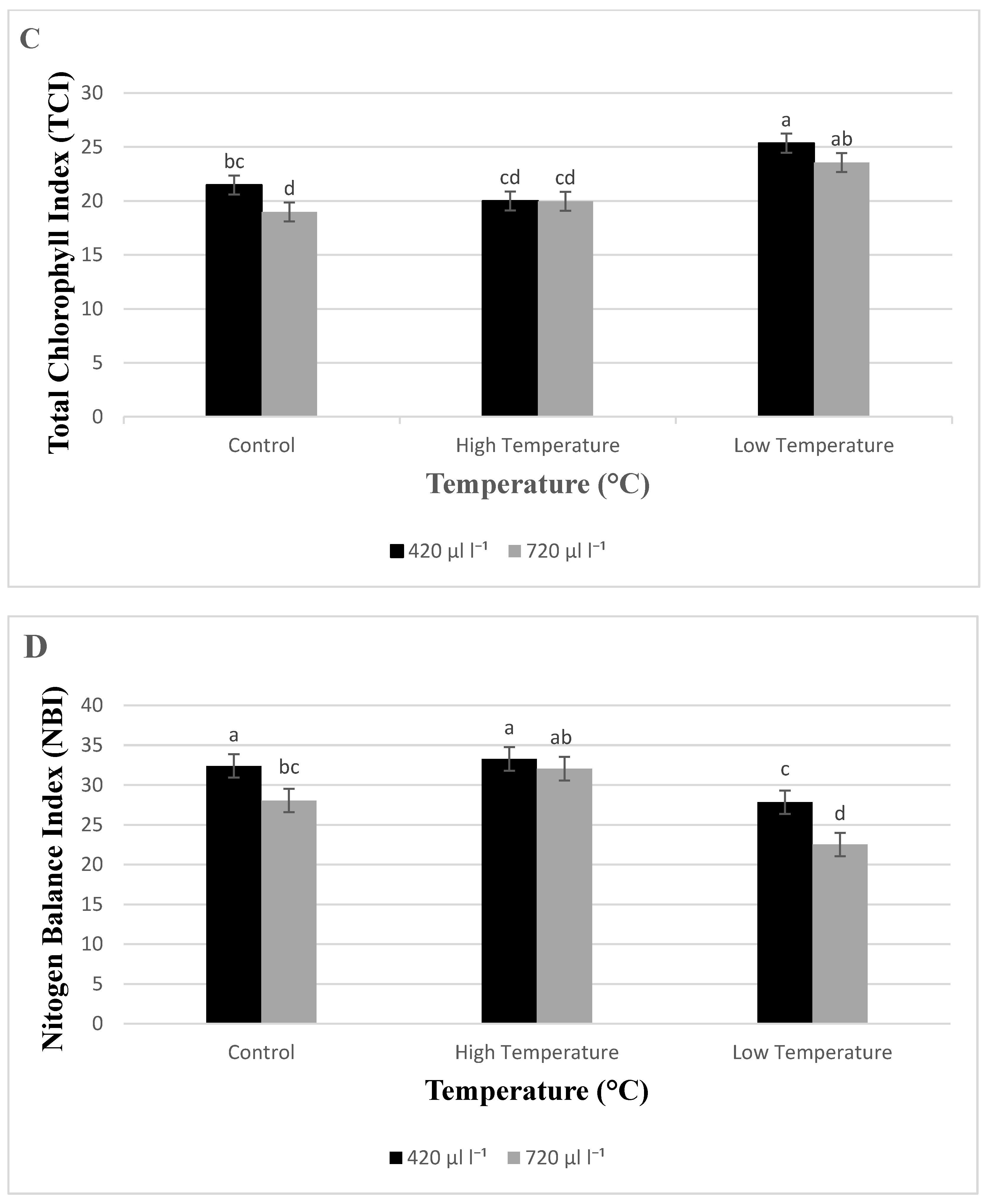
| Treatments | Measured Temperature (°C) | CO2 (μL L−1) | VPD (kPa) | Mean ET (L H2O d−1) | |
|---|---|---|---|---|---|
| Day/night | Day | Day/night | Day/night | ||
| Control | 30/22 °C, 420 μL L−1 | 26.27 ± 0.02 | 430.47 ± 0.98 | 1.82 ± 0.01 | 14.64 ± 1.41 |
| Control + High CO2 | 30/22 °C, 720 μL L−1 | 26.34 ± 0.01 | 731.21 ± 1.52 | 1.98 ± 0.01 | 12.60 ± 1.27 |
| High Temperature | 38/30 °C, 420 μL L−1 | 32.16 ± 0.49 | 434.19 ± 1.21 | 2.80 ± 0.07 | 8.74 ± 0.64 |
| Low Temperature | 20/12 °C, 420 μL L−1 | 19.53 ± 0.56 | 431.08 ± 0.66 | 0.89 ± 0.08 | 8.59 ± 0.47 |
| High Temperature + High CO2 | 38/30 °C, 720 μL L−1 | 32.09 ± 0.49 | 728.79 ± 0.83 | 2.87 ± 0.07 | 18.41 ± 1.86 |
| Low Temperature + High CO2 | 20/12 °C, 720 μL L−1 | 19.56 ± 0.57 | 724.78 ± 0.35 | 0.95 ± 0.09 | 6.39 ± 0.37 |
| Treatment | PH a | NN | BN | LA | LDW | SH DW | ST DW | RDW | RS Ratio b |
|---|---|---|---|---|---|---|---|---|---|
| 420 μL L−1 | |||||||||
| Control | 36.5 a | 7.1 b | 15.3 c | 1223.6 a,b | 4.479 b | 6.667 b | 2.188 c | 0.941 a | 0.140 b |
| High Temperature | 36.8 a | 8.5 a | 24.0 b | 1044.9 b | 4.366 b | 6.893 b | 2.528 b,c | 0.891 a | 0.128 b |
| Low Temperature | 16.5 c | 4.6 d | 6.4 e | 403.8 c | 1.909 d | 2.263 d | 0.354 d | 0.411 b | 0.198 a |
| 720 μL L−1 | |||||||||
| Control | 36.6 a | 7.0 b | 15.3 c | 1321.1 a | 5.779 a | 8.568 a | 2.789 a,b | 1.021 a | 0.119 b |
| High Temperature | 38.2 a | 8.9 a | 26.7 a | 1139.41 a,b | 5.227 a,b | 8.340 a | 3.113 a | 0.966 a | 0.121 b |
| Low Temperature | 19.6 b | 5.0 c | 9.0 d | 413.0 c | 2.948 c | 3.544 c | 0.596 d | 0.532 b | 0.155 b |
| Treatment c,d | *** | *** | *** | *** | *** | *** | *** | *** | ** |
| CO2 | ** | * | ** | NS | *** | *** | *** | NS | * |
| Trt * CO2 | NS | NS | NS | NS | NS | NS | NS | NS | NS |
| Treatment | PH a | NN | BN | LA | LDW | SH DW | ST DW | RDW | RS Ratio b |
|---|---|---|---|---|---|---|---|---|---|
| 420 μL L−1 | |||||||||
| Control | 61.7 a | 10.0 b | 29.9 a | 6946.3 a | 25.03 a,b | 58.081 a,b | 33.049 a,b | 6.841 a | 0.116 c |
| High Temperature | 51.4 b | 11.6 a | 24.5 b | 4616.3 b,c | 18.63 c | 43.274 c | 24.645 c | 7.387 a | 0.164 a |
| Low Temperature | 47.9 c,d | 7.2 d | 15.7 c | 4149.3 b,c | 16.62 c | 25.206 d | 8.589 d | 3.049 b | 0.123 b,c |
| 720 μL L−1 | |||||||||
| Control | 60.9 a | 10.1 b | 29.7 a | 8078.9 a | 28.39 a | 67.126 a | 38.733 a | 8.511 a | 0.128 b,c |
| High Temperature | 50.9 b,c | 11.4 a | 24.7 b | 5215.7 b | 20.65 b,c | 52.123 b,c | 31.469 b,c | 7.518 a | 0.142 a,b |
| Low Temperature | 47.3 d | 7.7 c | 17.1 c | 3582.0 c | 18.95 c | 29.113 d | 10.167 d | 4.599 b | 0.157 a |
| Treatment c,d | *** | *** | *** | *** | *** | *** | *** | *** | ** |
| CO2 | NS | NS | NS | NS | NS | NS | * | NS | NS |
| Trt * CO2 | NS | NS | NS | NS | NS | NS | NS | NS | * |
| Treatment | RL a | TRL | RSA | RAD | RV | RNT | RNF | RNC |
|---|---|---|---|---|---|---|---|---|
| 420 μL L−1 | ||||||||
| Control | 45.1 a | 4572.9 a | 854.3 a | 0.598 a | 14.00 a | 10052 a | 38545 a,b | 2412.6 b |
| High Temperature | 40.6 b,c | 3792.2 b,c | 623.4 b,c | 0.524 c | 9.68 b | 12271 a | 33856 b | 2475.1 b |
| Low Temperature | 36.9 c | 2701.2 d | 497.3 d | 0.584 a,b | 7.35 b | 5448 b | 17831 c | 1115.2 c |
| 720 μL L−1 | ||||||||
| Control | 46.7 a | 4159.1 a,b | 738.6 a,b | 0.561 a,b,c | 15.45 a | 12477 a | 46580 a | 3287.8 a |
| High Temperature | 43.0 a,b | 4194.4 a,b | 715.4 b,c | 0.541 b,c | 9.78 b | 10898 a | 31358 b | 2428.6 b |
| Low Temperature | 39.9 b,c | 3354.1 c | 602.1 c,d | 0.576 a,b | 8.65 b | 9624 a | 22960 c | 1480.0 c |
| Treatment b,c | *** | *** | *** | * | *** | ** | *** | *** |
| CO2 | NS | NS | NS | NS | NS | NS | NS | * |
| Trt*CO2 | NS | * | * | NS | NS | NS | NS | NS |
Publisher’s Note: MDPI stays neutral with regard to jurisdictional claims in published maps and institutional affiliations. |
© 2021 by the authors. Licensee MDPI, Basel, Switzerland. This article is an open access article distributed under the terms and conditions of the Creative Commons Attribution (CC BY) license (https://creativecommons.org/licenses/by/4.0/).
Share and Cite
Barickman, T.C.; Olorunwa, O.J.; Sehgal, A.; Walne, C.H.; Reddy, K.R.; Gao, W. Interactive Impacts of Temperature and Elevated CO2 on Basil (Ocimum basilicum L.) Root and Shoot Morphology and Growth. Horticulturae 2021, 7, 112. https://doi.org/10.3390/horticulturae7050112
Barickman TC, Olorunwa OJ, Sehgal A, Walne CH, Reddy KR, Gao W. Interactive Impacts of Temperature and Elevated CO2 on Basil (Ocimum basilicum L.) Root and Shoot Morphology and Growth. Horticulturae. 2021; 7(5):112. https://doi.org/10.3390/horticulturae7050112
Chicago/Turabian StyleBarickman, T. Casey, Omolayo J. Olorunwa, Akanksha Sehgal, C. Hunt Walne, K. Raja Reddy, and Wei Gao. 2021. "Interactive Impacts of Temperature and Elevated CO2 on Basil (Ocimum basilicum L.) Root and Shoot Morphology and Growth" Horticulturae 7, no. 5: 112. https://doi.org/10.3390/horticulturae7050112
APA StyleBarickman, T. C., Olorunwa, O. J., Sehgal, A., Walne, C. H., Reddy, K. R., & Gao, W. (2021). Interactive Impacts of Temperature and Elevated CO2 on Basil (Ocimum basilicum L.) Root and Shoot Morphology and Growth. Horticulturae, 7(5), 112. https://doi.org/10.3390/horticulturae7050112







